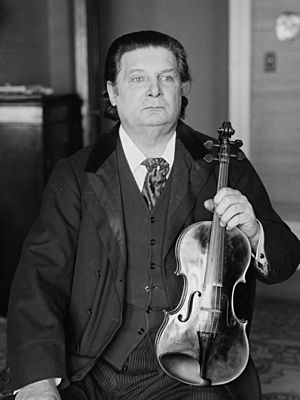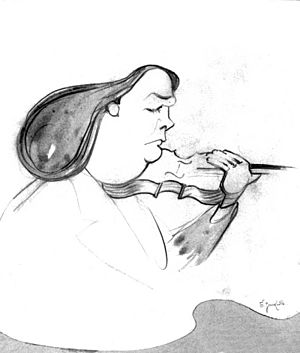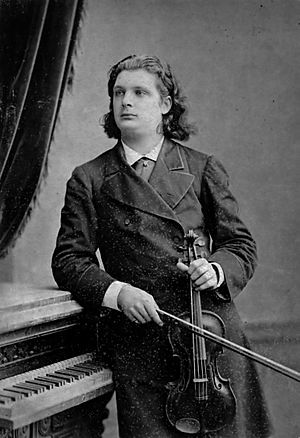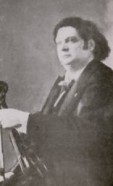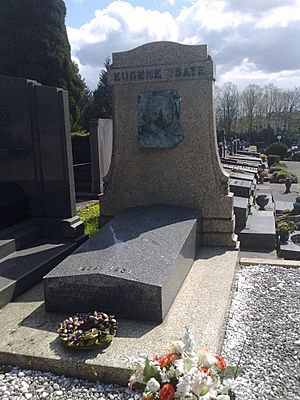Eugène Ysaÿe facts for kids
Eugène-Auguste Ysaÿe (born July 16, 1858 – died May 12, 1931) was a famous Belgian violin player, composer, and conductor. People called him "The King of the Violin" because he was so good.
Contents
Early Life and Learning Music
Eugène Ysaÿe was born in Liège, Belgium. He started learning the violin at age five from his father. Even though he later studied with very famous teachers, he always said his father taught him the most important basics.
In 1867, Eugène joined the Royal Conservatory of Liège. He studied with Désiré Heynberg and won a prize for his violin playing. He then learned from two other great violinists: Henryk Wieniawski for two years and Henri Vieuxtemps.
These teachers were part of a special way of playing the violin called the Franco-Belgian school. This style focused on playing with elegance, a full and smooth sound, and very precise hand movements. They used their whole forearm to move the bow, keeping their wrist and upper arm steady.
Becoming a Star Violinist
After finishing his studies, Ysaÿe became the main violinist in an orchestra that later became the famous Berlin Philharmonic. Many important musicians, like Franz Liszt and Clara Schumann, came to hear him play. One famous musician, Anton Rubinstein, even asked for Ysaÿe to join him on a concert tour!
When Ysaÿe was 27, he became a solo performer in Paris, which started his amazing career as a concert artist. The next year, he became a professor at the Brussels Conservatoire in Belgium. Teaching became a big part of his life, and he taught many talented students. Some of his famous students included Josef Gingold, William Primrose, and Nathan Milstein.
While teaching, Ysaÿe also traveled all over the world, playing concerts in Europe, Russia, and the United States. Even though he sometimes had health problems, especially with his hands, he always played his best. Many famous composers wrote music especially for him, like Claude Debussy, Camille Saint-Saëns, César Franck, and Ernest Chausson.
For example, César Franck wrote his famous Violin Sonata in A as a wedding gift for Ysaÿe and his wife in 1886. Ysaÿe loved this piece and played it everywhere he went for the rest of his life.
In 1886, Ysaÿe also started his own group called the Ysaÿe Quartet. This group performed new music, including Debussy's first String Quartet.
Composing and Conducting
As Ysaÿe got older and his health made it harder to perform as much, he spent more time teaching, conducting, and composing music. He had always loved writing music.
Some of his most famous works are the six Sonatas for Solo Violin, Op. 27. Each of these sonatas is dedicated to a different famous violinist and written in their unique style. He also wrote pieces for cello, two violins, and many Poèmes for violin and orchestra. Near the end of his life, he even wrote an opera called Peter the Miner.
In 1918, Ysaÿe became the music director for the Cincinnati Symphony Orchestra in the United States. He stayed there until 1922 and made several recordings with them.
Sadly, in 1931, Eugène Ysaÿe became very ill with diabetes. He passed away in his home in Forest, Belgium, and was buried in the Ixelles Cemetery in Brussels.
His Amazing Performing Style
As a performer, Ysaÿe was truly special and very original. Another famous musician, Pablo Casals, said he had never heard a violinist play so perfectly in tune before Ysaÿe.
Ysaÿe had a big, flexible sound. He used a lot of vibrato (a slight wavering in pitch that makes the sound richer), but he also knew when not to use it. He believed that music should always aim for "emotion, poetry, heart." The conductor Sir Henry Wood said that Ysaÿe could get more different sounds and colors from his violin than anyone else.
One of the most unique things about Ysaÿe's playing was his amazing use of rubato. This means he would sometimes speed up or slow down parts of the music to add expression, but he always made sure the overall rhythm stayed steady.
Ysaÿe was excellent at playing music by Romantic composers like Max Bruch and César Franck. But he was also admired for his performances of older music by Johann Sebastian Bach and Ludwig van Beethoven. His playing technique was brilliant and very precise.
To honor his memory, an international violin competition was started in Brussels. In 1951, it became the violin section of the famous Queen Elisabeth Music Competition.
Family and Friends
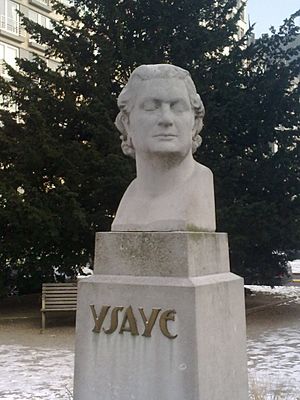
Eugène Ysaÿe was married twice. His first wife was Louise Bourdau, and they had five children together. On their wedding day, César Franck gave them his Violin Sonata as a gift, and Ysaÿe performed it at the celebration!
After Louise passed away, he married Jeanette Dincin, who was also a violinist and had been his student. She took care of him during his later, sicker years.
Ysaÿe's brother, Théo Ysaÿe, was also a talented pianist and composer. Eugène Ysaÿe was also good friends with Queen Elisabeth of Belgium. He even taught her violin, even though she wasn't very good at it! After his death, his widow continued to teach the Queen, and the Queen helped start the music competition in Ysaÿe's honor.
Ysaÿe was also a close friend of the famous French composer Claude Debussy. They wrote letters to each other and had great respect for one another. Debussy dedicated his only string quartet to Ysaÿe, who studied the music very carefully.
The Eugène Ysaÿe Collection
A special collection of Eugène Ysaÿe's belongings is kept at the Music Division of the Royal Library of Belgium. It includes about 700 letters, his original music scores, over 1,000 printed music books, many photographs, films, and old recordings. This collection helps people study his life and his music. Another collection of his music is kept in New York City at the Juilliard School.
Honors
- 1900: He was made an Officer in the Order of Leopold.
- 1919: He was made a Commander of the Order of Leopold.
Some of His Compositions
Eugène Ysaÿe wrote many pieces of music. Here are some of his most famous ones:
Works for Solo Violin
- 6 Sonatas for solo violin, Op. 27: These are very famous and challenging pieces for violin played alone. Each one is dedicated to a different famous violinist.
- Sonata No. 1 ("Joseph Szigeti")
- Sonata No. 2 ("Jacques Thibaud")
- Sonata No. 3 ("Georges Enescu")
- Sonata No. 4 ("Fritz Kreisler")
- Sonata No. 5 ("Mathieu Crickboom")
- Sonata No. 6 ("Manuel Quiroga")
Works for Violin and Piano
- Poème élégiaque, Op. 12
- Rêve d'enfant (Child's Dream), Op.14
Chamber Works
- Sonata for solo cello, in C minor, Op.28
- Sonata for two violins, in A minor, Op. posth.
Concertos and Other Works with Orchestra
- Poème élégiaque (Poème No.1) in D minor, for violin and orchestra, Op.12
- Extase (Poème No.4), for violin and orchestra, Op.21
- Poème nocturne (Poème No.7), for violin, cello and orchestra, Op.29
Operas
- Piére li houyeû (Pierre the Miner) 1931: This was his only opera, written in the Walloon language. It tells a story about miners in the Liège region. Ysaÿe was very ill when it premiered, but he listened to it from his hospital room.
Images for kids
See also
 In Spanish: Eugène Ysaÿe para niños
In Spanish: Eugène Ysaÿe para niños


